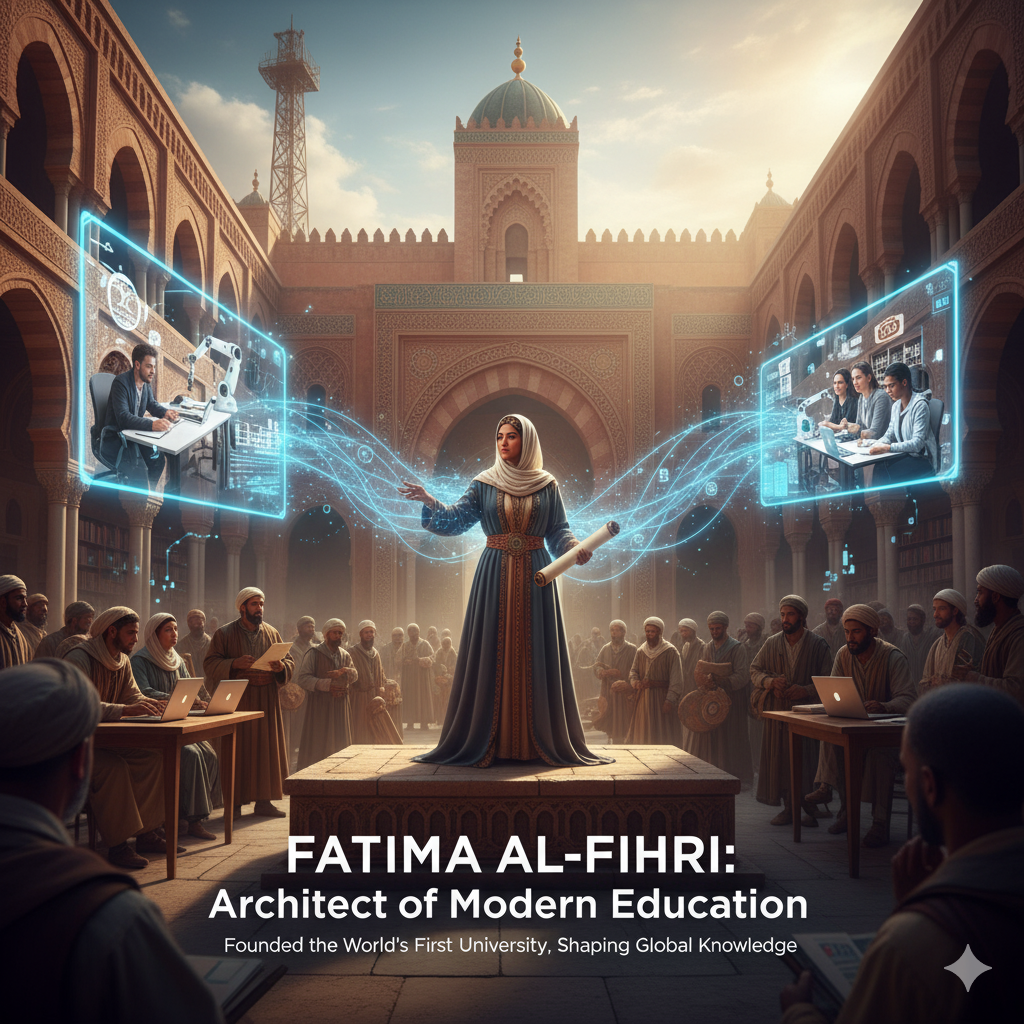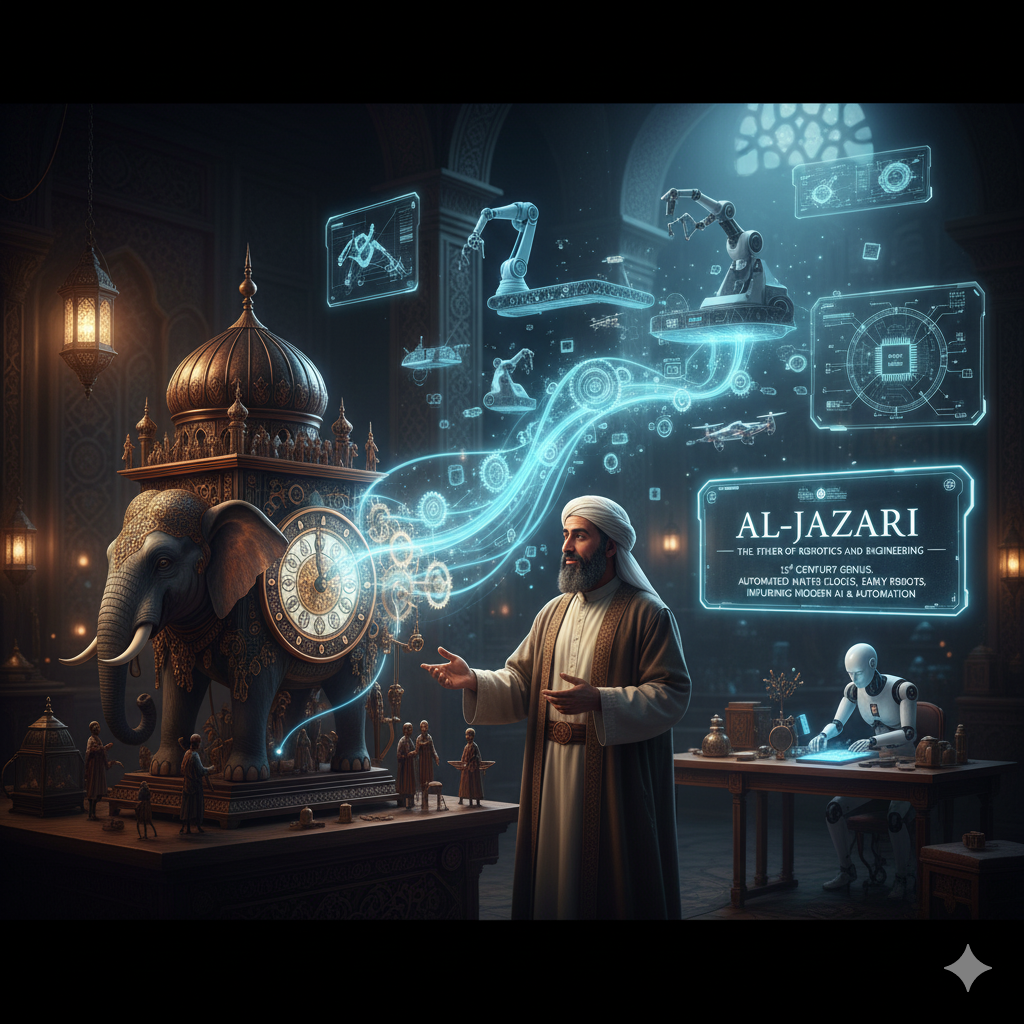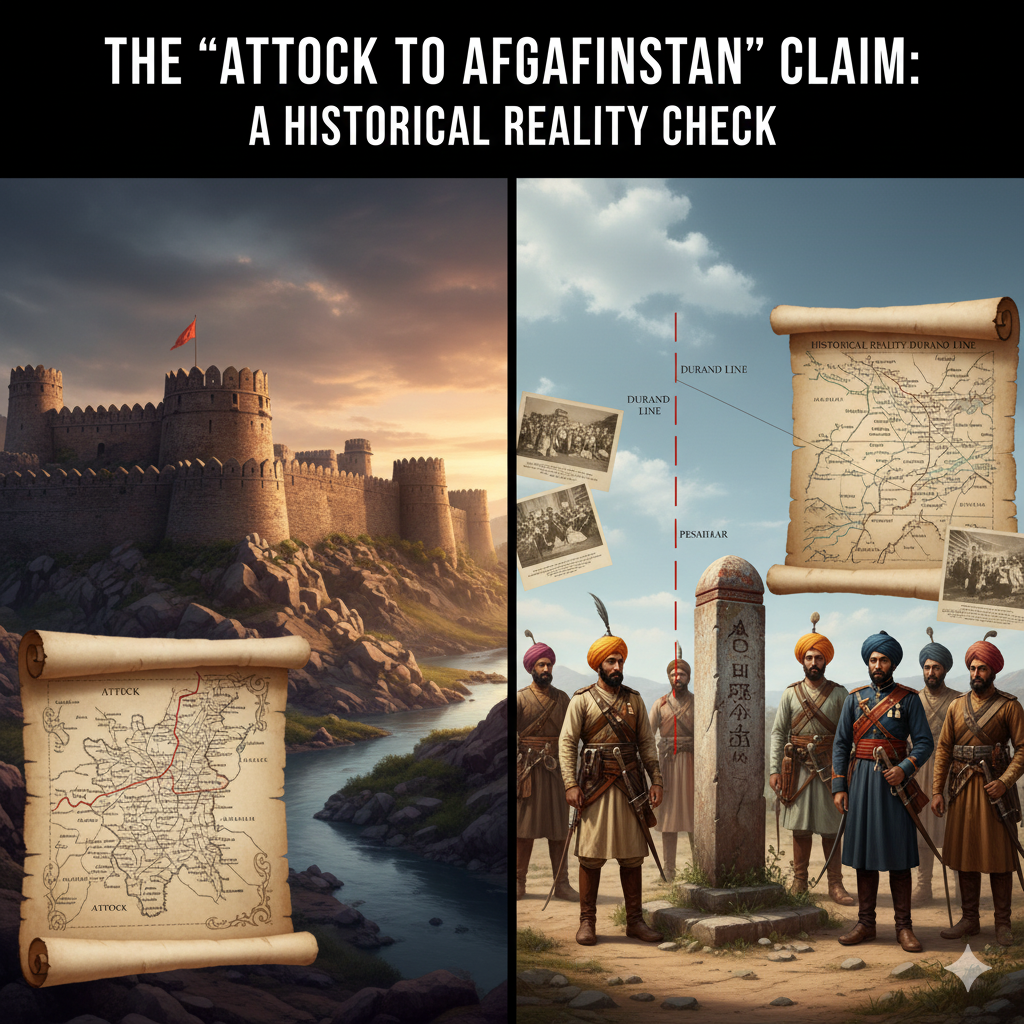In the 9th century, when most of the world was bound by class, gender, and tradition, one woman imagined a space where knowledge would be free of walls.
Her name was Fatima al-Fihri, the daughter of a prosperous merchant in Fez, Morocco — and the founder of Al-Qarawiyyin University, the oldest continuously operating university in the world.
Centuries before Oxford or Harvard, Fatima built a sanctuary of learning that welcomed scholars from across Africa, the Middle East, and Europe. Her vision shaped the foundations of what we now call higher education — a place where intellect, faith, and dialogue met without boundaries.
Early Life and Vision
Born around 800 CE in Kairouan, Tunisia, Fatima al-Fihri grew up in a family that valued both faith and education. Her father, Mohammed al-Fihri, was a wealthy merchant who migrated to Fez during the Idrisid dynasty — a period when the city was becoming a thriving hub of culture, trade, and scholarship.
When her father and husband passed away, Fatima inherited considerable wealth. But instead of building palaces or hoarding riches, she turned her inheritance toward a cause that would serve generations to come: knowledge.
She envisioned a place not just for prayer, but for learning — where scholars could gather to study theology, mathematics, astronomy, medicine, grammar, logic, and philosophy. This idea would become Al-Qarawiyyin — a fusion of mosque and university, a concept far ahead of its time.
Founding of Al-Qarawiyyin University
In 859 CE, Fatima began construction of Jami’at al-Qarawiyyin, naming it after her birthplace, Kairouan. She personally oversaw the project, fasting daily until the foundation was complete — a symbolic act of devotion linking piety to intellect.
The institution started as a mosque, but over the centuries evolved into a comprehensive university. It attracted scholars from across the Islamic world — and beyond — becoming one of the key transmitters of knowledge to medieval Europe.
Notable figures such as Ibn Khaldun, Maimonides, and Gerard of Cremona studied or referenced works that passed through its halls. It offered subjects in law (fiqh), grammar, astronomy, medicine, and philosophy, effectively bridging the gap between religious and worldly learning.
Intellectual Legacy and Influence on Global Education
When Fatima al-Fihri laid the first foundation stones of Al-Qarawiyyin University, she wasn’t just constructing walls of stone and plaster — she was building a blueprint for civilization.
Her university became the heart of intellectual life in Fez, and a beating artery of learning for the entire Islamic Golden Age.
A New Model of Learning
Before Al-Qarawiyyin, education across the world was fragmented. Knowledge was passed down in temples, monasteries, or informal study circles. Fatima al-Fihri changed that.
She envisioned an institution that merged faith, science, and philosophy — one that honored revelation while encouraging reason.
The Al-Qarawiyyin University operated on a unique model:
- Open Access: It was not restricted by class or nationality. Students from Africa, Andalusia (Spain), and even Christian Europe came to study there.
- Integrated Curriculum: Alongside Qur’anic studies and jurisprudence, the university taught mathematics, astronomy, logic, grammar, geography, medicine, and music.
- Scholarly Certification: It introduced an early version of the Ijazah system — the world’s first degree structure — allowing students to earn formal recognition for their mastery of a subject, centuries before the first European universities adopted similar systems.
This holistic model — combining spiritual discipline, academic rigor, and open inquiry — would go on to influence the creation of universities across the Mediterranean world.
Fez: The Beacon of Learning
Under Fatima’s guidance and later through dynastic patronage, Fez became a cosmopolitan center of knowledge. Al-Qarawiyyin’s libraries held thousands of manuscripts — many of which are still preserved today, including early copies of the Qur’an, treatises on astronomy, and rare works of Aristotle and Euclid translated into Arabic.
The university became a hub for translation and transmission. Scholars translated ancient Greek and Latin texts into Arabic, preserving them through centuries of turmoil in Europe.
From there, these texts were later translated into Latin in medieval Spain — reigniting European intellectual life during the Renaissance.
Thus, Fatima’s vision — born of personal devotion and social responsibility — became a silent revolution that spanned continents and centuries.
Impact on European and Modern Education
Historians often trace the roots of modern universities — Bologna (1088), Paris (1150), Oxford (1096) — to medieval Europe. Yet, their academic DNA bears clear resemblance to the systems perfected centuries earlier in the Muslim world, particularly at Al-Qarawiyyin.
European scholars who traveled to Fez and other Islamic centers returned home with ideas that would define the Western university model:
- The collegiate system, modeled on the communal environment of madrasahs.
- The degree structure (Ijazah → Bachelor → Master → Doctorate).
- The faculty system, dividing knowledge into specialized disciplines.
Even the Latin term universitas echoes the spirit of Al-Qarawiyyin — a universal gathering of learners.
Fatima al-Fihri’s educational vision thus became a bridge between civilizations, linking Islamic scholarship with European enlightenment.
A Symbol of Women’s Empowerment
Beyond education, Fatima’s story stands as a rebuke to historical amnesia about women’s roles in intellectual history.
At a time when few women had public agency, she not only funded but founded and managed one of the most significant institutions in the world.
Her leadership was neither ornamental nor symbolic — she was directly involved in the architectural design, financial planning, and scholarly governance of the university.
She remains a reminder that Islamic civilization’s educational revolution was gender-inclusive at its core.
Fatima’s example dismantles the false narrative that women were absent from scientific and intellectual life in the medieval Muslim world.
Her name stands beside the likes of Aisha bint Abu Bakr (the great scholar of Hadith), Lubna of Cordoba (mathematician and calligrapher), and Rabi’a al-Adawiyya (mystic and philosopher) — women who carried the torch of learning in their time.
Legacy and Preservation
Today, Al-Qarawiyyin University still stands in Fez — recognized by UNESCO and Guinness World Records as the oldest continuously operating university in the world.
Its ancient halls continue to host classes in Islamic law, Arabic grammar, and natural sciences — a living link to the 9th century and Fatima’s enduring vision.
Her legacy resonates in the mission of every modern institution that values inclusivity, intellectual curiosity, and moral responsibility.
Universities across the globe, from Cairo to Cambridge, echo her belief that knowledge should not be hoarded — it should serve humanity.
More than a founder, Fatima al-Fihri was a philosopher of education, centuries ahead of her time.
She transformed wealth into wisdom, faith into architecture, and vision into a living monument to the human mind.
The Visionary Spirit Behind Al-Qarawiyyin
What made Fatima al-Fihri extraordinary was not simply that she built a university — it was how and why she did it.
Her project began as a spiritual offering, not an act of prestige. She saw knowledge as a form of worship, a continuation of divine revelation in human intellect. The construction of Al-Qarawiyyin was thus performed as an act of ibadah — every decision, from the design of the courtyard to the alignment of the prayer hall, was rooted in her religious devotion.
Fatima personally fasted through the entire period of construction, seeking blessings for her work. She gave instructions that the builders use only locally sourced materials, symbolizing a union between the community and the pursuit of knowledge.
The main prayer hall was designed to open into learning spaces, physically representing the union of faith and reason — a hallmark of classical Islamic architecture and philosophy.
Administrative Brilliance and Institutional Structure
Once completed, Fatima didn’t simply hand the institution over to others. She set up a sustainable system for its operation. The university was endowed through waqf — a charitable trust — ensuring its independence from royal politics and state interference.
This model, replicated across the Islamic world, guaranteed that knowledge would remain free, accessible, and protected.
It’s the same financial structure still used by modern universities’ endowments, a system that began with her.
Under her guidance, Al-Qarawiyyin established:
- A system of deans and scholars (Ulama) who supervised disciplines.
- A central library, which later became one of the most important manuscript collections in the world, containing works in Arabic, Latin, and Amazigh.
- Residential accommodations for traveling students — a concept later mirrored in the dormitory systems of Oxford and Cambridge.
Fatima’s management made Al-Qarawiyyin not only an academic center but a prototype for the self-sustaining university model.
Cultural and Intellectual Ecosystem
Fez, through Al-Qarawiyyin, became the intellectual heartbeat of North Africa.
Students and scholars came from Andalusia, Sub-Saharan Africa, the Maghreb, Egypt, and even Sicily and France. They brought manuscripts, ideas, and dialects — creating one of the earliest examples of an intercultural academic environment.
Subjects taught there reflected the era’s openness:
- Qur’anic sciences, jurisprudence (fiqh), and Hadith formed the moral foundation.
- Mathematics, astronomy, logic, grammar, medicine, and chemistry were taught as disciplines of the natural world.
- Philosophy and linguistics encouraged debate, interpretation, and comparative reasoning.
This synthesis of spiritual and empirical sciences became a hallmark of Islamic education and influenced the Renaissance vision of integrated knowledge.
Intellectual Lineage and Global Transmission
Al-Qarawiyyin produced and influenced generations of scholars who became the backbone of medieval and early modern intellectual movements:
- Ibn Khaldun, the sociologist and historian who studied human civilization and founded early theories of economics and social science.
- Ibn Rushd (Averroes), the philosopher whose commentaries on Aristotle shaped European thought for centuries.
- Maimonides, the Jewish philosopher and physician, who carried Andalusian scholarship into Egypt.
- Leo Africanus, the traveler and diplomat, whose works introduced Africa’s geography and culture to Europe.
Through these figures, Fatima’s university became the bridge that carried knowledge from the East to the West — directly feeding into the European Renaissance.
When scholars from Bologna, Padua, and Paris began forming their own universities, they adopted the curriculum models, examination methods, and certification systems already perfected at Al-Qarawiyyin.
Her institution, unknowingly, became the root of the modern university tradition.
Architectural and Spiritual Legacy
Architecturally, Al-Qarawiyyin is a masterpiece of Islamic geometric design and functional beauty.
The campus features:
- A vast prayer hall with a zellige-tiled mihrab.
- A courtyard designed for light and airflow to foster contemplation.
- A minaret — one of the earliest in Morocco — symbolizing the ascent from knowledge to enlightenment.
- And the Al-Qarawiyyin Library, founded in the 14th century but tracing its lineage to Fatima’s vision, still open today — making it the oldest working library in the world.
Inside, the library preserves original Qur’anic manuscripts written on camel skin, mathematical treatises, and even the earliest works of astronomy and medicine in Arabic.
Every corner of this structure whispers her name — a woman who, without throne or army, shaped civilization through intellect.
Historical Recognition and Modern Revival
While her name faded in Western records for centuries, Fatima al-Fihri has recently been rediscovered as a symbol of global learning and women’s empowerment.
- UNESCO recognizes her as the founder of the world’s first university.
- UN Women lists her among the “Mothers of Knowledge.”
- Her story is now included in modern curricula across Morocco and the Middle East, reclaiming her rightful place in educational history.
Today, Al-Qarawiyyin continues to function under the University of Fez, offering degrees in Islamic law and modern sciences — a testament that Fatima’s vision remains alive over 1,160 years later.
Philosophical Legacy
At the heart of Fatima’s work was a simple yet profound belief:
that knowledge is sacred, and ignorance is the greatest poverty.
She built a system where study was not separated from spirituality — a model desperately needed in the modern age of specialization.
Her philosophy reminds us that education must not only produce skilled people but good people — those who carry knowledge with humility and use it in service to others.
In Fatima’s world, learning was worship, teaching was charity, and knowledge was justice.
Her life remains a living argument that when a single person acts from conviction and faith, entire civilizations shift.
Conclusion – Fatima al-Fihri: A Legacy That Transcends Time
Fatima al-Fihri was not just a founder of a university; she was a visionary who reshaped the very idea of education. In a time when women were often confined to the private sphere, she built a monument of knowledge that would influence generations, civilizations, and continents.
Through Al-Qarawiyyin University, she created a space where intellect met spirituality, where inquiry was encouraged alongside devotion, and where students of diverse cultures and religions could gather in the pursuit of truth. Her vision anticipated the modern university system, from structured curricula to degrees, to the integration of multiple disciplines under one roof.
Fatima’s story is also a beacon of women’s empowerment. She reminds the world that leadership, innovation, and intellectual contribution are not bound by gender. Her courage, wisdom, and devotion forged a legacy that continues to inspire scholars, educators, and students around the globe.
In a modern world often divided by ideology and culture, her life offers a timeless lesson: that knowledge is a bridge, not a barrier; that faith and reason can coexist; and that one person’s vision, when rooted in service and humility, can leave an enduring mark on humanity.
Fatima al-Fihri’s enduring message is clear: education is sacred, knowledge is universal, and wisdom knows no gender.
She stands as a testament that even a single individual, with courage and foresight, can illuminate the path of civilization for generations to come.
















